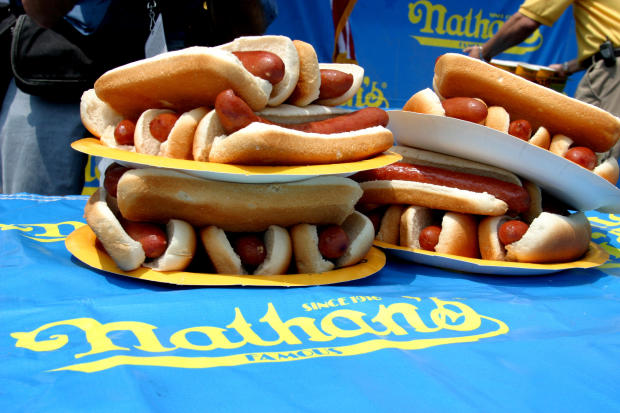What does a hot dog eating contest do to your stomach? Experts detail the health effects of competitive eating.
Competitive eating champ Joey Chestnut gulps down dozens of hot dogs each Fourth of July at the Nathan's Famous Hot Dog Eating Contest — and comes back do it again year after year. But no one really knows what long-term impacts it might have on his body or the bodies of other competitive eaters.
Chestnut has eaten as many as 76 hot dogs and buns in 10 minutes, setting a world record in 2021, and downed 63 to win again in 2022.
Long-term consequences are not well known because competitive eating is a relatively new sport with a relatively small number of participants, Academy of Nutrition and Dietetics spokesperson Debbie Petitpain said.
But health experts say the practice does raise some potential health concerns.
The stomach, which normally contracts after people eat, could end up permanently stretched out, Dr. Rajeev Jain with Texas Digestive Disease Consultants said. It could also impact gastric emptying, the process by which food moves from the stomach into the duodenum.
"Nobody is going to get funded for a randomized, controlled trial where you say, 'Hey, I'm going to quadruple your stomach size and see what happens to you,' because there's no reason to do that type of thing from a medical perspective," Jain said.
Still, gastroenterologists have some idea of what happens when a trained competitor speed-eats dozens of hot dogs. A 2007 University of Pennsylvania study published in the American Journal of Roentgenology offers some clues.
What happens to the stomach of competitive eaters?
In the study, a control subject and a competitive speed eater — a 29-year-old man who was ranked in the top 10 worldwide — were asked to eat as many hot dogs as they could during a 12-minute period. While most contests call for including the buns, the study stuck to just hot dogs. Researchers studied the participants' stomachs beforehand, and asked each man to ingest an effervescent agent and high-density barium before eating the hot dogs so they could watch the food as it moved through the participants' bodies.
Based on fluoroscopy scans during the study, the researchers found the competitive eater's stomach was capable of expanding to accommodate significantly more extra food.
The control subject ate seven hot dogs before he felt sick and needed to stop. At the 10-minute mark, the competitive speed eater had ingested 36 hot dogs; researchers asked him to stop because they were worried for him.
"His stomach now appeared as a massively distended, food-filled sac occupying most of the upper abdomen, with little or no gastric peristalsis and emptying of a small amount of barium into the duodenum," the researchers wrote.
At the end, they said his abdomen protruded "enough to create the distinct impression of a developing intrauterine pregnancy."
Dr. David Metz, who was one of the authors of the study and has worked as a professor of medicine at the University of Pennsylvania's Perelman School of Medicine, said speed eaters have the ability to relax their stomachs so they can ingest more food.
The average, empty stomach is about the size of a fist or a fist and a half, he said. It's made of two parts: a receptacle on top and a grinder, of sorts, on the bottom. The stomach muscles will stretch to accommodate food as people eat, but every muscle "has its point at which there's no return."
"You could potentially end up with a big bag that doesn't contract properly," Metz said.
The study noted that competitive eaters have reported using "varying methods of training" to try to expand their stomach capacity, including ingesting "vast amounts of cabbage" or "water loading," which can be hazardous.
In the immediate aftermath of eating contests, participants report feeling extremely bloated and tired. They also report gastrointestinal distress in the day or two after a competition.
Other side effects of competitive eating
Competitive eating impacts more than just the stomach. Participants can become sweaty, light headed and faint in the aftermath, experts said. Some speed eaters have noted pain in their face, jaw and neck afterwards because of the amount of chewing and swallowing involved.
"Some athletes have reported arthritis in the jaw, excruciating pain in that area," Petitpain said.
It's not just the large quantity of food that's a problem. It's also the type of food. Hot dogs are high in sodium. According to the nutritional information on Nathan's website, one of its Original Coney Island natural casing beef hot dogs contains 170 calories, 16 grams of fat (including 6 grams of saturated fat), and 480 milligrams of sodium. Other varieties are higher. The USDA's 2020–2025 Dietary Guidelines recommend that Americans consume less than 2,300 milligrams of sodium each day. It would take fewer than five hot dogs to go over the daily limit.
"If they're absorbing too much sodium, their thirst mechanism is going to kick in and they're going to drink a lot of water afterwards," Jain said. "My concern is, if your stomach is so full of food, how are you going to get the other compensatory liquids in?"
Ingesting excessive sodium can impact kidney function. The spike in sodium can also cause blood pressure to soar, putting pressure on blood vessels in the body, Petitpain said.
"If there's a weak spot in those blood vessels that gets stressed, that could cause a heart attack," Petitpain said. "Or if there is a bursting of the vessels in the brain, a stroke."
The high level of fat ingested could cause nausea, diarrhea and gastrointestinal distress, Petitpain said.
During the annual contest, the competitors also eat the buns, which means a lot of carbs.
"This large load of protein, of carbohydrates, of starches, all these things, they're now going to be dumped into the small intestine. And while this is going on, your body has to crank up its insulin," Jain said.
But all told, if the competitive eater goes back to a normal diet once a contest is over, their body should regulate back to normal.
"Your body is a very adaptive organism," Metz said. "The kidneys flush out the excess sodium and other micronutrients"
There are still dangers, though. Beyond the immediate stomach pains competitors might feel, there are much worse possibilities. Competitors who vomit risk aspirating or tearing the lining of their esophagus, Metz said.
People have died during eating competitions. In 2017, a 20-year-old college student died after choking during a pancake-eating contest. That same year, a 42-year-old man asphyxiated during a donut eating contest.
"There's a lot of danger involved and many of us have been very concerned about this," Metz said.
Major League Eating, the organization that oversees professional competitions, does have safety teams on hand at events, and says it "strongly opposes and discourages home training of any kind." The organization did not respond to repeated requests for comment.





